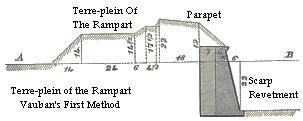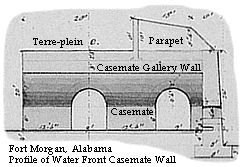 A terre-plein in both permanent and field fortifications
may be defined as a clear and nearly level area immediately in rear of a
protective structure. In the masonry revetted rampart walls of land front
permanent fortifications the terre-plein of the rampart was usually about
eight feet below the elevation of the interior crest of the rampart parapet
and was 24 to 35 feet wide. In this case the terre-plein was defiladed from
direct hostile fire passing over the top of the parapet and served as an
area where troops and materials could be either collected for the defense
of the rampart or move from point to point on the rampart. This also held
true for the terre-plein of the covered way. In casemated coastal defense
fortifications the terre-plein on top of the A terre-plein in both permanent and field fortifications
may be defined as a clear and nearly level area immediately in rear of a
protective structure. In the masonry revetted rampart walls of land front
permanent fortifications the terre-plein of the rampart was usually about
eight feet below the elevation of the interior crest of the rampart parapet
and was 24 to 35 feet wide. In this case the terre-plein was defiladed from
direct hostile fire passing over the top of the parapet and served as an
area where troops and materials could be either collected for the defense
of the rampart or move from point to point on the rampart. This also held
true for the terre-plein of the covered way. In casemated coastal defense
fortifications the terre-plein on top of the
 casemate gallery wall generally served as platforms for barbette
batteries of heavy guns that were intended to deliver a plunging fire onto
the decks of hostile warships. In these cases the terre-pleins were generally
20 to 30 feet wide, depending on the thickness of the casemate wall and thickness
of the parapet shielding the barbette battery. In field fortifications the
clear area enclosed by the boundaries formed by the foot of the banquette
slope was denominated the terre-plein. Clear space within an enclosed work
or immediately in rear of the parapet of an open work was required for the
maneuver and easy operation of a fortification's reserve, the free circulation
of casemate gallery wall generally served as platforms for barbette
batteries of heavy guns that were intended to deliver a plunging fire onto
the decks of hostile warships. In these cases the terre-pleins were generally
20 to 30 feet wide, depending on the thickness of the casemate wall and thickness
of the parapet shielding the barbette battery. In field fortifications the
clear area enclosed by the boundaries formed by the foot of the banquette
slope was denominated the terre-plein. Clear space within an enclosed work
or immediately in rear of the parapet of an open work was required for the
maneuver and easy operation of a fortification's reserve, the free circulation
of troops to remove and care for the wounded, distribution of
ammunition and stores, and the myriad other activities required to adequately
defend a field fortification. troops to remove and care for the wounded, distribution of
ammunition and stores, and the myriad other activities required to adequately
defend a field fortification.
|